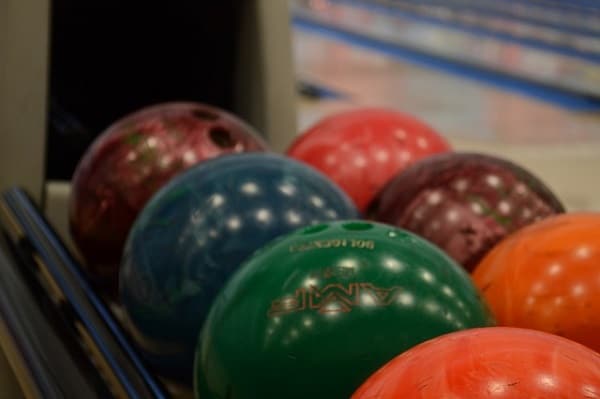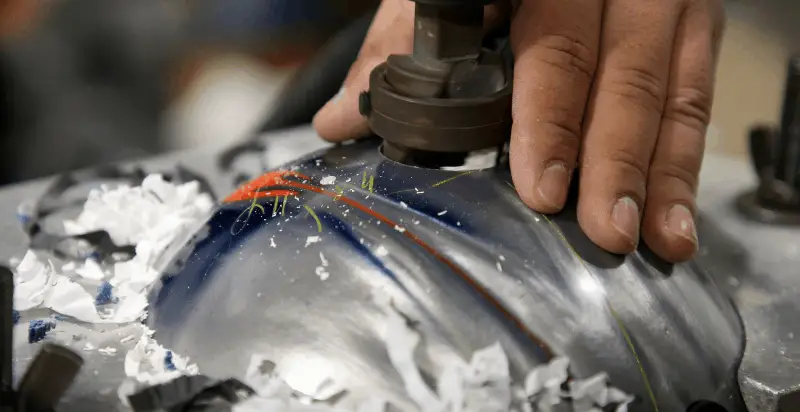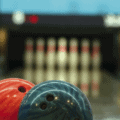At some point, anyone who’s been bowling may be sitting aside and waiting for their turn, and while doing so a thought pops into their head: what exactly is a bowling ball made of?
These tools for victory may seem simple on the outside, but they are actually quite a bit more complex than you may have even imagined!

Bowling balls have massively evolved through time, and are very technologically advanced in the current day in comparison to their older counterparts. So, what are they made out of?
We’re here to answer that nagging question in the back of your mind!
So, What Were They Made Of?
You may not have known this, but bowling has been around for thousands of years in one form or another. There are two main types: lawn bowling and pin bowling. Nobody really knows 100% when bowling started, but it’s been suggested by archaeologists and historians that it’s been around for at least 5000 years.
Back in ye olde days, most of the first known bowling balls were made out of Lignum vitae. In our terms, that would be a very hard kind of wood. Wooden bowling balls were also used back during the 1800s for ninepin bowling.
Back in 1905 though, things started to change with the emergence of the first rubber bowling ball. It didn’t really take off at this point though - that wouldn’t happen until around 1914.
The rubber bowling ball had its heyday from there up until around 1959 when the plastic and polyester style of bowling balls were created. These kinds of bowling balls are still in circulation today!
The Bowling Balls of Today
While we do still use plastic and polyester bowling balls, technology has actually advanced beyond this. Generally, plastic/polyester bowling balls are used by children, beginners and are usually used as a straight line spare bowling ball by many.
The main problem with polyester and plastic bowling balls is that they don’t create enough friction on the lane, and a lot of more serious bowlers became frustrated by the fact that they would just skid down the lane and they wouldn’t have a lot of back end action snapping into the pin pocket.
This is where a new player entered the game back into the 80s: the urethane bowling ball. Around this time, urethane based lane finishes started becoming more common because they were fairly cost effective.
As a result, urethane balls were being made that had softer cover stocks and they were more porous. They performed a lot better than polyester balls to lane conditions too.
Urethane balls are still used a lot today, and they provide a basis for the newer technologies. Now, a lot more aggressive bowling ball cover stocks are being made that are created to be heavily porous and friction heavy so they react heavily to lane conditions.
This allows bowlers with more experience to be able to maximize on their shots and will allow them to read the lane conditions, ultimately resulting in increased hook violence and overall pin carry.
For most professional and league bowlers, reactive resin bowling balls are the strike bowling ball of choice.
These kinds of bowling balls tend to combine the consistently evolving cover stock technology with a number of different internal core types and outlays in order to make a new kind of bowling ball that is designed to maximize on lane reaction to improve scores and the overall effectiveness of the intricate bowler shot patterns.
What’s Inside?
So, here we’re going to cover what’s inside of a ten pin bowling ball - this is the most widely played form of bowling! Usually, ten pin bowling balls consist of a three part construction - an outside cover stock, an outer core that consists of filler material, and a hardened inner core.
Of course, every bowling ball company’s list of materials for the construction of their products are mostly concealed, there are some elements that are fairly consistent among manufacturers for both the outer and the inner cores of a bowling ball.
Usually, the outer core of a bowling ball tends to be lighter than the inner core, and it tends to consist of a filler material that uses a number of different kinds of substances, such as glass beads and polyester. It’s usually this part of the bowling ball that is altered by the manufacturer to create the final weight and density ratio of the bowling ball.
As far as the inner core of the bowling ball is concerned, it usually consists of powdered metal oxides the are mixed with resin, along with a chemical catalyst to harden the entirety of the core into a pseudo-metal state.
These cores are then able to be shaped in a bunch of different ways. Some are shaped similarly to a pancake, whereas some are symmetrically spherical, and others are imbalanced intentionally.
Every kind of core shape has different kinds of impacts on the hook potential and straight line efficacy. A symmetrical core tends to hook a lot less and with significantly less sharpness than asymmetrical cores.
What Is the Purpose of a Bowling Ball Cover Stock?
The cover stock of the bowling ball is perhaps the most important part of the performance of the ball as a whole. The cover stock of the ball is actually responsible for between 60% to 80% of the ball’s performance on the lanes, with the remainder coming down to the different core structures and mass/density ratios of the ball’s inner and outer core structure.
The cover stock of the bowling ball is the part that gets in touch with the lanes. Because of this, it’s the main thing that creates friction in order to give the power that the bowler’s shot needs, and it helps contribute to the snap and overall hook potential.
Bowling balls designed for high performance made out of polyurethane with reactive resin cover stocks are also designed to be porous to absorb the lane oil in a way that the ball properly reacts according to the lane’s oil patterns. This kind of reactivity is important for any advanced bowlers that want to improve their hooks and add extra power to their back end reaction as a whole, in addition to pin carry.
Overall, a bowling ball cover stock actually does the vast majority of the work for you because it’s the part that is in contact with the lane.
What More Should I Know?
So now you’ve heard it - what bowling balls are made out of. Now, you may be left with a few more questions, so we’ve set out to answer one or two of them to keep your curiosity piqued!
First of all, does a bowling ball float? Well, that ultimately depends of the weight of the ball you are using. Every single bowling ball has a different density based on its weight, and usually a regulation 12 pound bowling ball is the closest in density to water.
Because of this, a regulation bowling ball that is around 12 pounds of lighter is going to be able to float in the water. If the ball is 13 pounds of heavier it is likely to sink because the density overall is more than water.
Next question: can bowling balls go bad? Now, you may be surprised to hear this, but bowling balls do have a shelf life, even if they don’t spoil. If you do clean your bowling ball on a regular basis and do the routine maintenance that is needed, then your bowling ball will likely maintain efficacy and good quality for between five to ten years.
The key problem when it comes to a ball’s longevity is the overall condition of the cover stock and the condition of the ball’s core. A lot of modern balls designed for high performance are made with porous and softer cover stocks than older bowling balls. Sure, this is ideal if your ball is in good condition, but over time it could spell trouble.
If your bowling ball cover stock is cracked then you may as well wave it goodbye. Likewise, if the core of your bowling ball comes apart or if it loses its stationary place in the depths of the ball, it can make your ball become unbalanced which means it will be pretty much useless to you out on the lanes.
Conclusion
As you can see, bowling balls have dramatically changed through time from their early days eons ago to where they are now. There’s a lot more to a bowling ball than what you may initially think too! It’s really worth examining just how much goes into a bowling ball to see how much work goes into them.
The answer to the question ‘what are bowling balls made of’ isn’t always the most straightforward because different manufacturers will use different materials and methods, but hopefully this article has cleared up some of the key points for you!

I’m Lia and I love playing games. I started this site to share things with friends and they encouraged me to post more and now I’m trying to share things with the world – indoor and outdoor sports, and board and bar games. I write about things like Bocce, Croquet, Billiards, Darts and other fun ways to enjoy time with your friends and family!







